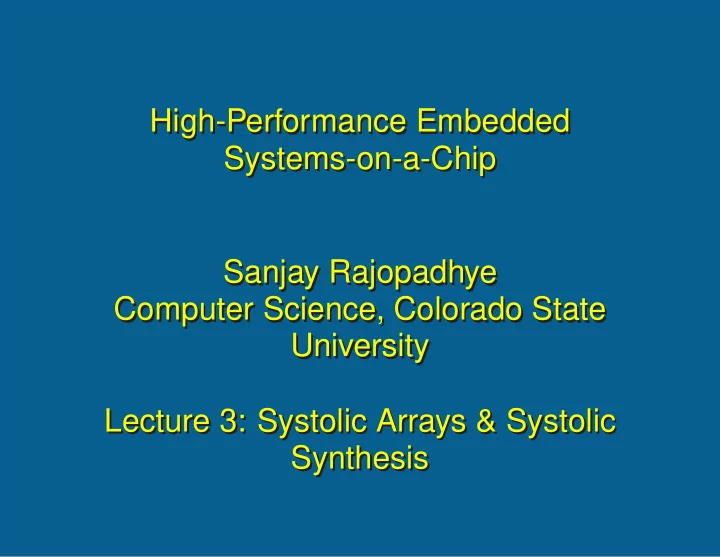

High-Performance Embedded High-Performance Embedded Systems-on-a-Chip Systems-on-a-Chip Sanjay Rajopadhye Sanjay Rajopadhye Computer Science, Colorado State Computer Science, Colorado State University University Lecture 3: Systolic Arrays & Systolic Lecture 3: Systolic Arrays & Systolic Synthesis Synthesis
2 Systolic Synthesis With mathematical specification (SARE + reductions), do the following (not necessarily in order): 1. Serialize reductions and Align inputs and outputs 2. Localize dependences 3. Schedule the SARE 4. Allocate the computation to processors 5. Transform the SARE 6. Generate the HDL
3 Example: Convolution Initial specification: n − 1 � w j ∗ x i − j y i = j =0
4 Serialization & Alignment Replace (unbounded fan-in) � by sequence of binary additions. Align input and output vars. ��� ��� ��� ��� ��� ��� ��� ��� ���� ���� ���� ���� ��� ��� ���� ���� ��� ��� ��� ��� ��� ��� ��� ��� ���� ���� ���� ���� ��� ��� ���� ���� ��� ��� ��� ��� ��� ��� ��� ��� ���� ���� ���� ���� ��� ��� ���� ���� ��� ��� ��� ��� yi = Y [ i, n − 1] ��� ��� ��� ��� ���� ���� ���� ���� ��� ��� ���� ���� ��� ��� ��� ��� ��� ��� ��� ��� ���� ���� ���� ���� ��� ��� ���� ���� ��� ��� ��� ��� ��� ��� ���� ���� ���� ���� ��� ��� ���� ���� ��� ��� � ��� ��� j = 0 : wj ∗ xi − j ��� ��� ��� ��� ���� ���� ���� ���� ��� ��� ���� ���� ��� ��� ��� ��� ��� ��� ��� ��� ���� ���� ���� ���� ��� ��� ���� ���� ��� ��� Y [ i, j ] = j > 0 : Y [ i, j − 1]+ ��� ��� ��� ��� ��� ��� ��� ��� ���� ���� ���� ���� ��� ��� ���� ���� ��� ��� ��� ��� wj ∗ xi − j ��� ��� ��� ��� ���� ���� ���� ���� ��� ��� ���� ���� ��� ��� ��� ��� ��� ��� ���� ���� ���� ���� ��� ��� ���� ���� ��� ��� ��� ��� ��� ��� ��� ��� ���� ���� ���� ���� ��� ��� ���� ���� ��� ��� ��� ��� ��� ��� ��� ��� ��� ��� ���� ���� ���� ���� ��� ��� ��� ��� ��� ��� ��� ��� ���� ���� ���� ���� ��� ��� ���� ���� ��� ��� ��� ��� ��� ��� ��� ��� ���� ���� ���� ���� ��� ��� ��� ���
5 Localization/Uniformization Remove unbounded fan-out (i.e., “long”) dependences. yi = Y [ i, n − 1] ��� ��� ���� ���� ���� ���� ��� ��� ���� ���� ��� ��� ���� ���� � j = 0 : W [ i, j ] ∗ X [ i, j ] ��� ��� ���� ���� ���� ���� ��� ��� ���� ���� ��� ��� ���� ���� Y [ i, j ] = j > 0 : Y [ i, j − 1]+ ��� ��� ���� ���� ���� ���� ��� ��� ���� ���� ��� ��� ���� ���� ��� ��� ���� ���� ���� ���� ��� ��� ���� ���� ��� ��� ���� ���� ��� ��� ���� ���� ���� ���� ��� ��� ���� ���� ��� ��� ���� ���� W [ i, j ] ∗ X [ i, j ] � ��� ��� ���� ���� ���� ���� ��� ��� ���� ���� ��� ��� ���� ���� j = 0 : xi ��� ��� ���� ���� ���� ���� ��� ��� ���� ���� ��� ��� ���� ���� X [ i, j ] = j > 0 : X [ i − 1 , j − 1] ��� ��� ���� ���� ���� ���� ��� ��� ���� ���� ��� ��� ���� ���� ��� ��� ���� ���� ���� ���� ��� ��� ���� ���� ��� ��� ���� ���� ��� ��� ���� ���� ���� ���� ��� ��� ���� ���� ��� ��� ���� ���� � i = 0 : wj ��� ��� ���� ���� ���� ���� ��� ��� ���� ���� ��� ��� ���� ���� W [ i, j ] = ��� ��� ���� ���� ���� ���� ��� ��� ���� ���� ��� ��� ���� ���� i > 0 : W [ i − 1 , j ] ��� ��� ���� ���� ���� ���� ��� ��� ���� ���� ��� ��� ���� ����
6 Scheduling & Allocation ��� ��� ���� ���� ��� ��� ���� ���� ��� ��� ���� ���� ��� ��� ��� ��� ���� ���� ��� ��� ���� ���� ��� ��� ���� ���� ��� ��� ��� ��� ���� ���� ��� ��� ���� ���� ��� ��� ���� ���� ��� ��� ��� ��� ���� ���� ��� ��� ���� ���� ��� ��� ���� ���� ��� ��� ��� ��� ���� ���� ��� ��� ���� ���� ��� ��� ���� ���� ��� ��� ��� ��� ���� ���� ��� ��� ���� ���� ��� ��� ���� ���� ��� ��� ��� ��� ���� ���� ��� ��� ���� ���� ��� ��� ���� ���� ��� ��� ��� ��� ���� ���� ��� ��� ���� ���� ��� ��� ���� ���� ��� ��� ��� ��� ���� ���� ��� ��� ���� ���� ��� ��� ���� ���� ��� ��� ��� ��� ���� ���� ��� ��� ���� ���� ��� ��� ���� ���� ��� ��� ��� ��� ���� ���� ��� ��� ���� ���� ��� ��� ���� ���� ��� ��� ��� ��� ���� ���� ��� ��� ���� ���� ��� ��� ���� ���� ��� ��� ��� ��� ���� ���� ��� ��� ���� ���� ��� ��� ���� ���� ��� ���
Recommend
More recommend